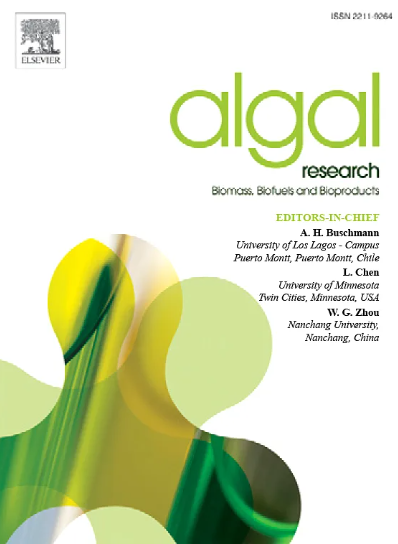鉴定一种新型血球菌菌株并确定其特征,该菌株对副鞘氨醇沉着病菌感染具有抗性
IF 4.6
2区 生物学
Q1 BIOTECHNOLOGY & APPLIED MICROBIOLOGY
Algal Research-Biomass Biofuels and Bioproducts
Pub Date : 2024-11-06
DOI:10.1016/j.algal.2024.103791
引用次数: 0
摘要
血球藻(Haematococcus pluvialis)的商业养殖受到病原体 Paraphysoderma sedebokerense 的威胁,导致天然虾青素产业遭受重大损失。本研究成功鉴定出一种新的血球藻菌株 WBG-26,该菌株在实验室和开放式赛道池塘中均表现出对 P. sedebokerense 的高度抗性。比较分析表明,抗性菌株 WBG-26 的细胞壁更厚,特定单糖含量更低,这可能与抗性密切相关。RNA 序列分析显示了不同的基因表达谱,其中 29 个上调基因和 25 个下调基因被确定为抗性的关键基因。通过生物信息学分析,我们确定了几个潜在的抗性基因和抗性相关基因,如编码受体样激酶、富亮氨酸重复、转录因子、CAZymes 和热休克蛋白的基因,这些基因可能在防御反应中发挥关键作用。这项研究是对微藻多种防御机制的全面调查,为培育抗病微藻菌株的生物技术应用提供了启示。本文章由计算机程序翻译,如有差异,请以英文原文为准。

Identification and characterization of a novel Haematococcus pluvialis strain resistant to Paraphysoderma sedebokerense infection
The commercial culture of Haematococcus pluvialis is threatened by the pathogen Paraphysoderma sedebokerense, leading to substantial losses in the natural astaxanthin industry. This study successfully identified a novel H. pluvialis strain WBG-26, which exhibited high resistance to P. sedebokerense in both laboratory and open raceway ponds. Comparative analysis showed that the resistant strain WBG-26 had a thicker cell wall and lower levels of specific monosaccharides which may be closely related to resistance. RNA-sequencing analysis revealed differential gene expression profiles, with 29 up-regulated and 25 down-regulated genes identified as crucial for resistance. Using bioinformatics analysis, we identified several potential resistance genes and resistance-related genes, such as those encoding receptor-like kinases, leucine-rich repeat, transcription factors, CAZymes, and heat shock proteins, which may play critical roles in defense response. This study represents a comprehensive investigation of multiple defense mechanisms of microalgae, providing insights into breeding disease-resistant microalgal strains for biotechnological applications.
求助全文
通过发布文献求助,成功后即可免费获取论文全文。
去求助
来源期刊

Algal Research-Biomass Biofuels and Bioproducts
BIOTECHNOLOGY & APPLIED MICROBIOLOGY-
CiteScore
9.40
自引率
7.80%
发文量
332
期刊介绍:
Algal Research is an international phycology journal covering all areas of emerging technologies in algae biology, biomass production, cultivation, harvesting, extraction, bioproducts, biorefinery, engineering, and econometrics. Algae is defined to include cyanobacteria, microalgae, and protists and symbionts of interest in biotechnology. The journal publishes original research and reviews for the following scope: algal biology, including but not exclusive to: phylogeny, biodiversity, molecular traits, metabolic regulation, and genetic engineering, algal cultivation, e.g. phototrophic systems, heterotrophic systems, and mixotrophic systems, algal harvesting and extraction systems, biotechnology to convert algal biomass and components into biofuels and bioproducts, e.g., nutraceuticals, pharmaceuticals, animal feed, plastics, etc. algal products and their economic assessment
 求助内容:
求助内容: 应助结果提醒方式:
应助结果提醒方式:


